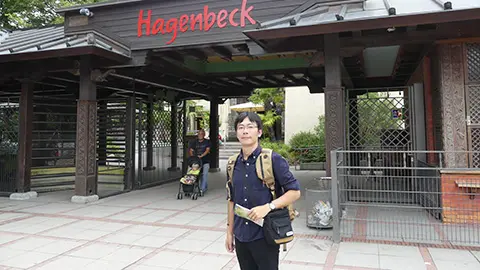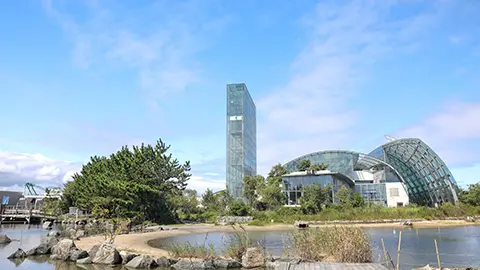VOL.196 SEPTEMBER 2024
JAPAN’S ENJOYABLE PUBLIC AQUARIUMS
Enjoy Dynamic Ecological exhibits at the Northern Daichi Aquarium

In 2012, the aquarium reopened with the help of NAKAMURA Hajime, Japan’s only aquarium producer.
Photo: ISHIZAWA Yoji
The Northern Daichi Aquarium (Mountain Aquarium)* is located at the Road Station Onneyu Onsen Michi-no-Eki** in Kitami City, Hokkaido. This popular aquarium is known for breeding the rare freshwater Sakhalin taimen, or ito in Japanese, which grow to over one meter in length.
Kitami City is located in the eastern part of Hokkaido, where the temperature varies so widely, from a high of 35°C in summer to a low of -20°C in winter. Onneyu Onsen is a hot spring resort located in Kitami City, an area blessed with nature and surrounded by three national parks: Akanmashu, Daisetsuzan, and Shiretoko. The resort has a history of over 120 years since its opening. The Northern Daichi Aquarium was built as a part of the Road Station Onneyu Onsen Michi-no-Eki as a symbol of the hot spring resort. Aquarium director YAMAUCHI So told us about its special features.
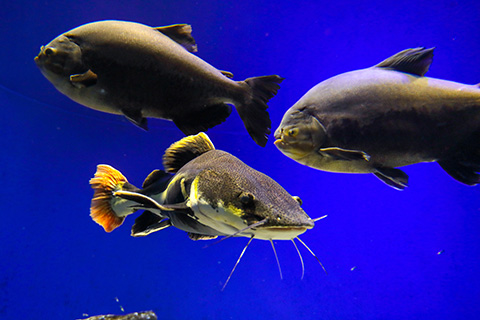
Photo: ISHIZAWA Yoji
“The aquarium specializes in exhibiting freshwater fish from Hokkaido and tropical freshwater fish from around the world, as well as other freshwater creatures. The Hokkaido freshwater fish exhibit area features an aquarium that reproduces the seasonal changes in rivers, as well as over 20 Sakhalin taimen (ito), Japan’s largest freshwater fish, which grow to more than 1 meter in length. A member of the salmon family, this fish is an endangered species currently found only in some rivers and lakes in Hokkaido. Visitors can see these endangered fish swimming around in the large tank. In the tropical freshwater fish of the world area, visitors can see beautifully grown fish in a tank that uses hot spring water from the nearby hot springs.”
At this aquarium, visitors can watch rare Sakhalin taimen (ito) prey on their food.
“Sakhalin taimen (ito) prey on rainbow trout on Tuesdays, Thursdays, and Saturdays at 2:30 p.m. from late May through January. This is a time for visitors to learn about the value of life through the fact that living things must eat something to survive.”
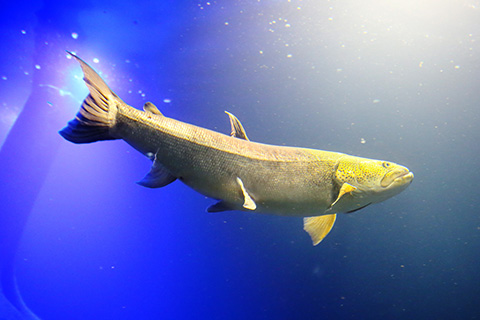
Photo: ISHIZAWA Yoji
In this aquarium, ecological environments have also been recreated, and visitors can enjoy seeing fish as they are in the rivers where they live and swim. According to NAKAMURA Hajime***, Japan’s only aquarium producer who plans aquarium exhibits, the aquarium worked especially hard on the Four Seasons of Northern Daichi exhibit. It is an ingenious exhibition method developed from the novel idea of making the most of the natural features of Kitami City, one of the coldest cities in Hokkaido.

The Four Seasons of Northern Daichi, a water tank reproducing the frozen surface of a river in winter.
Photo: Northern Daichi Aquarium
“During the winter here, the temperature often drops below -20 degrees Celsius, with lakes and rivers freezing over. The aquarium recreated this environment with a tank located outside. The surface of the water usually freezes in this tank for about a month during the frigid season, from January to February, with fish visibly lingering beneath the ice, awaiting spring.”
Another highlight is a tank that recreates a waterfall basin where visitors can see the rare Dolly Varden trout (oshorokoma).
“The beautiful Dolly Varden trout (oshorokoma) is a member of the char family**** and lives in the cold waters of Hokkaido. A waterfall tank was created to reproduce the rapids produced by waterfalls. In this way, visitors can watch this trout swimming vigorously as it would in the majestic rivers of Hokkaido. You will truly feel as if they have stepped into a waterfall basin.”
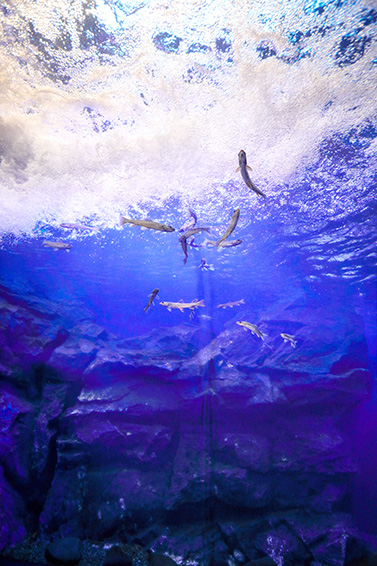
Photo: ISHIZAWA Yoji
All of the exhibits are realistic and dynamic. They capture the scenery and dynamism of Hokkaido’s magnificent nature and the ecology of the fish that live there.
“Visitors from overseas can scan the QR codes next to the exhibits to read explanations in English, Chinese (traditional/simplified), and Korean. I hope that visitors will visit the aquarium when they come to Hokkaido sometime.”
* The official legal name is the Mountain Aquarium. The nickname Northern Daichi Aquarium was chosen by local residents a year after opening and is used exclusively except in official municipal documents. Moreover, the Japanese word daichi means “earth” or “vast land” in English.
** Rest facilities built on public roads in Japan with certain requirements and which must be registered with the government through an application by the municipality. Currently, there are more than 1,200 registered (as of August 2024). In addition to offering a chance to refresh, these facilities must also have tourist information and provide local development facilities for the community.
*** NAKAMURA Hajime: After he began working at Toba Aquarium, he was involved in PR and marketing and helped to successfully renovate the aquarium. After he left Toba, he became Japan’s first aquarium producer and has been involved in the renovations of numerous aquariums, including Enoshima Aquarium (Kanagawa prefecture) and Sunshine Aquarium (Tokyo), as well as this aquarium.
**** A freshwater fish in the family Salmonidae. An example of Japan’s mountain stream fish.
By MOROHASHI Kumiko
Photo: ISHIZAWA Yoji; Northern Daichi Aquarium
